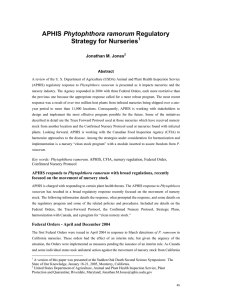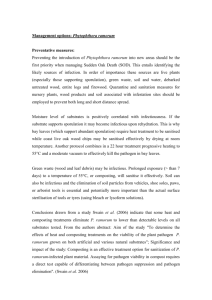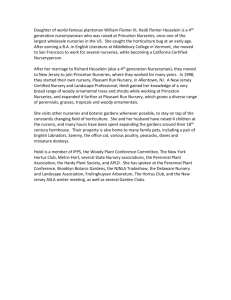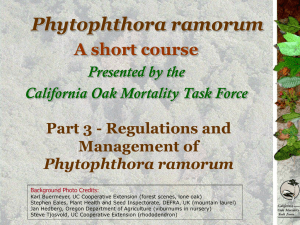Phytophthora ramorum and North American Nurseries Janice Alexander 1
advertisement
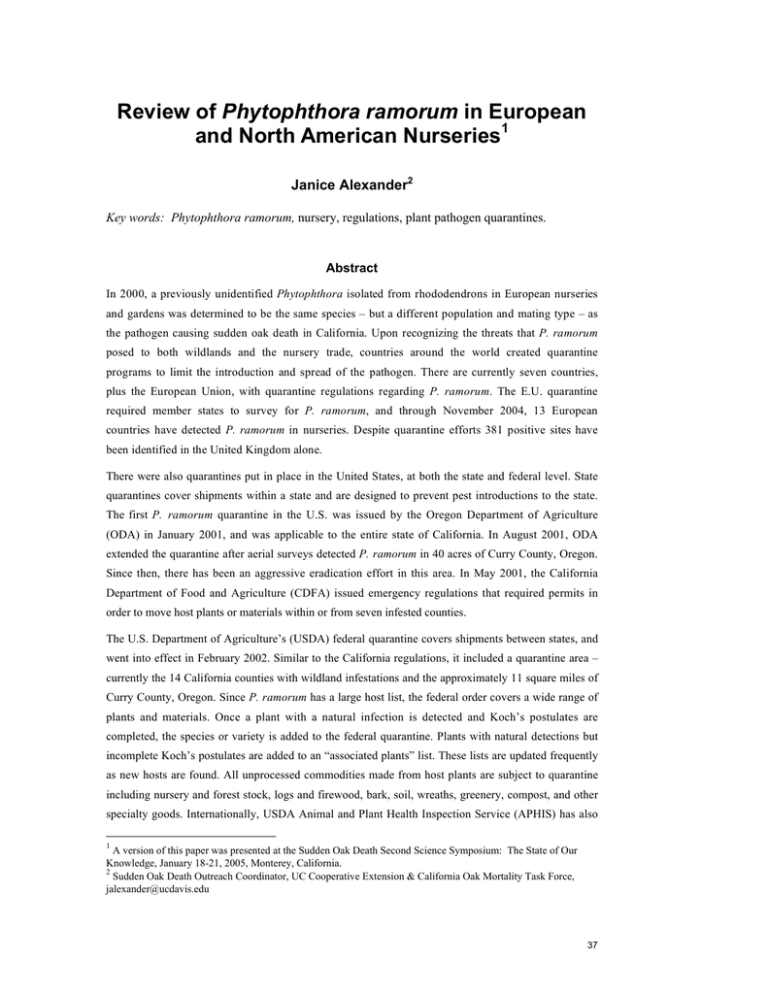
Review of Phytophthora ramorum in European and North American Nurseries1 Janice Alexander2 Key words: Phytophthora ramorum, nursery, regulations, plant pathogen quarantines. Abstract In 2000, a previously unidentified Phytophthora isolated from rhododendrons in European nurseries and gardens was determined to be the same species – but a different population and mating type – as the pathogen causing sudden oak death in California. Upon recognizing the threats that P. ramorum posed to both wildlands and the nursery trade, countries around the world created quarantine programs to limit the introduction and spread of the pathogen. There are currently seven countries, plus the European Union, with quarantine regulations regarding P. ramorum. The E.U. quarantine required member states to survey for P. ramorum, and through November 2004, 13 European countries have detected P. ramorum in nurseries. Despite quarantine efforts 381 positive sites have been identified in the United Kingdom alone. There were also quarantines put in place in the United States, at both the state and federal level. State quarantines cover shipments within a state and are designed to prevent pest introductions to the state. The first P. ramorum quarantine in the U.S. was issued by the Oregon Department of Agriculture (ODA) in January 2001, and was applicable to the entire state of California. In August 2001, ODA extended the quarantine after aerial surveys detected P. ramorum in 40 acres of Curry County, Oregon. Since then, there has been an aggressive eradication effort in this area. In May 2001, the California Department of Food and Agriculture (CDFA) issued emergency regulations that required permits in order to move host plants or materials within or from seven infested counties. The U.S. Department of Agriculture’s (USDA) federal quarantine covers shipments between states, and went into effect in February 2002. Similar to the California regulations, it included a quarantine area – currently the 14 California counties with wildland infestations and the approximately 11 square miles of Curry County, Oregon. Since P. ramorum has a large host list, the federal order covers a wide range of plants and materials. Once a plant with a natural infection is detected and Koch’s postulates are completed, the species or variety is added to the federal quarantine. Plants with natural detections but incomplete Koch’s postulates are added to an “associated plants” list. These lists are updated frequently as new hosts are found. All unprocessed commodities made from host plants are subject to quarantine including nursery and forest stock, logs and firewood, bark, soil, wreaths, greenery, compost, and other specialty goods. Internationally, USDA Animal and Plant Health Inspection Service (APHIS) has also 1 A version of this paper was presented at the Sudden Oak Death Second Science Symposium: The State of Our Knowledge, January 18-21, 2005, Monterey, California. 2 Sudden Oak Death Outreach Coordinator, UC Cooperative Extension & California Oak Mortality Task Force, jalexander@ucdavis.edu 37 GENERAL TECHNICAL REPORT PSW-GTR-196 informed the European Commission of restrictions on their member country exports of P. ramorum host plants and propagative material. Through 2002, it was widely believed that P. ramorum was an issue in European nurseries but not in their wildlands, while the opposite was believed true in North America (i.e., a forestry, not a nursery, issue). There had been only one P. ramorum detection from a single nursery in the U.S. in 2001, which occurred on rhododendrons in a California nursery surrounded by a heavy forest infestation in the quarantine area. In 2002, the CDFA surveyed an additional 99 nurseries in 17 counties and more than 8500 surrounding acres and did not detect the pathogen. Even through 2003 the pathogen had been detected in only seven California nurseries within the infested (quarantine) area. Outside the infested (quarantine) area, there were 10 P. ramorum nursery detections: in Stanislaus County, California, and in Oregon, Washington and British Columbia. Several of the Pacific Northwest detections were found to be the European (A1) strain, and were not associated with North American infestations. As part of the federal quarantine program, a U.S. National Nursery Survey was also implemented in 2002 – all results were negative in the U.S. for the National Survey. Twenty-five states contributed survey data in 2003 – one nursery in Oregon was found positive as part of the National Survey. Just as P. ramorum was being detected in some North American nurseries, European forest trees were being found infected by the pathogen. In December 2003, the U.K. and the Netherlands reported that P. ramorum was infecting the trunks of beech, southern red oak, northern red oak, and horse chestnut. In all cases, the infected trees are located near P. ramorum-infected rhododendrons. In the midst of all of this, another newly discovered Phytophthora, P. kernovii, (initially called Phytophthora taxon C) has also been found causing tree deaths in the U.K. Back in the U.S., the national survey of nurseries continued. In February 2004, as a result of the national survey and a simultaneous trace-back survey from Washington State, P. ramorum was detected on plants at a large nursery in Southern California. The nursery is over 400 miles from the nearest known infested forest, the climate in the vicinity of the nursery is usually hot and dry, and disease symptoms became apparent only after a period of heavy rain. After positive finds in this and other west coast nurseries, additional trace-forward surveys tracked plants to other states. At a cost of more than $15 million, over 1.6 million plants were investigated by states and USDA APHIS to check for infections and destroy them. In one nursery in Southern California alone, over 1 million camellias, worth $9 million, were destroyed because of a P. ramorum infestation. In response to the finds in west coast nurseries, USDA APHIS issued an emergency order in March 2004. After the announcement, 17 states enacted emergency measures to limit plant imports from California. Reacting to these state restrictions, the National Plant Board and National Association of State Departments of Agriculture both got involved to discuss regulations on the federal and state levels. Soon after, in April 2004, USDA APHIS re-issued an order restricting all California commercial nurseries from shipping any host or associated plants out of state, and changed the diagnostic rules for P. ramorum to PCR-only. Not long after, the California Association of Nurserymen and Garden Centers filed a federal suit against the state of Kentucky, a state limiting imports from California beyond that allowed in the federal regulations. The state of Kentucky has since come into compliance with the federal regulations. 38 Proceedings of the sudden oak death second science symposium: the state of our knowledge The final tally for 2004, including trace-forwards, trace-backs, and the national survey, was P. ramorum detections at 176 sites in 21 States. In cooperation with the USDA Forest Service, a national wildland survey was also carried out, with one positive site detected in Golden Gate Park, San Francisco, California. In response to these numerous finds in 2004, the USDA issued a new emergency order for nurseries in December that further restricted shipping of host material across state lines. 39

